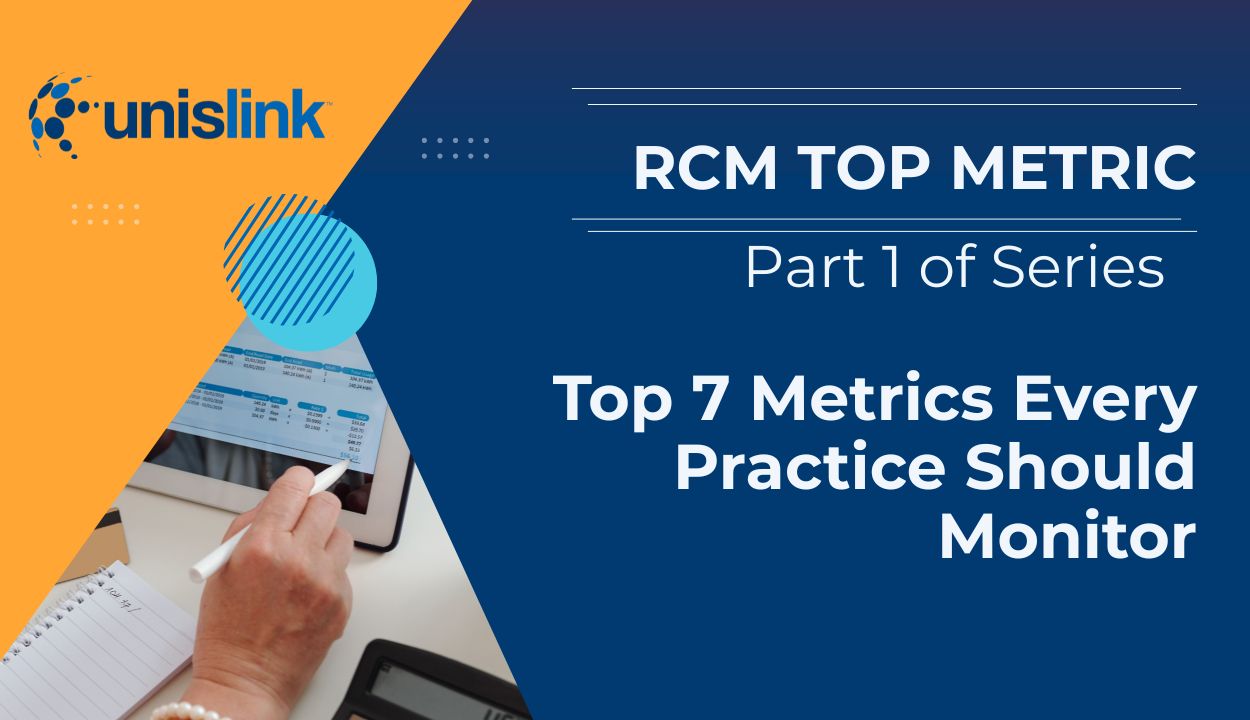Successful healthcare providers understand that managing a medical operation goes way beyond providing excellent patient care. To maintain a financially stable practice, executives must monitor their revenue cycle metrics for key performance indicators.
With regular monitoring of KPIs, a high performing medical practice will experience excellent patient satisfaction with efficient RCM billing processes and speedy healthcare insurance reimbursements.
You can measure the health of your own practice against the seven metrics listed below to provide a clear snapshot of your financial performance. These RCM metrics are the best data points in the industry for identifying more reimbursement potential and better cash flow. These KPIs should be monitored monthly to track trendlines for improvement.
The Most Important Revenue Cycle Metrics for Any Medical Practice
1. Days in A/R
What it Measures: How long it takes your practice to get paid after a service is rendered.
Why it Matters: High days in A/R can point to delays in medical claims submission, insurance payer denials or concerns, or inefficient follow-up processes to payment delays. Keeping this number low means quicker access to revenue, and efficient medical billing operation.
Formula for Days in A/R
Total Patient Accounts Receivable ÷ Average Daily Charges
Step 1: Determine your total current receivables and subtract any credits (funds you owe to others).
Step 2: Calculate your average daily charge amount (total gross charges for the last 12 months / 365 days).
Step 3: Divide the total from Step 1 (receivables) by the total from Step 2 (charge amount).
Example: Let’s say your total annual charges are $18,000,000.
If your total A/R is $2,000,000 and your average daily charges are $49,000, your Days in A/R = 41. $2,000,000/$49,000=41
[Days in A/R Industry Benchmark: <40 days; Top Tier Benchmark is 28-32 days]
In this example, if you reduce your Days in A/R by 10, you’ll experience a surge of cash flow up to $490,000 ($49,000 per day x 10).
2. A/R Over 120 Days
What it Measures: The percentage of your patient accounts receivables that are more than 120 days old.
Why it Matters: A high percentage of receivables more than 120 days old is a big red flag for RCM performance. Medical claims this old are much harder to collect from insurance companies and often signal a problem with claim denial rates or patient collection and payment issues.
Formula for A/R Over 120 Days
Dollar value of A/R > 120 days ÷ Value of Total A/R
Example: Your total receivables are $2,500,000 with total A/R > 120 days at $1,300,000. The percentage of outstanding accounts receivable that are past due by 120 days or more is at 52%.
Some receivables will be out to insurance and some will be owed by patients, which is why this metric should be separated by ‘out to insurance’ and ‘patient responsibility’. Identifying where the greatest portion of your receivable is outstanding, allows your team to focus on the highest impact area of your AR.
[A/R >12 Days Industry Benchmark: 15% – 20%; Top Tier Benchmark is 10% – 15%]
3. Average Revenue per Encounter (ARE)
What it Measures: The average amount of revenue your practice collects per patient encounter.
Why it Matters: This revenue cycle metric helps you understand the true value of each encounter and the financial effectiveness of your medical coding and payer mix collections.
The ARE metric is truth-telling because it measures patient reimbursement rates regardless of your charges. The best way to measure your performance is to trend ARE on a monthly basis. For example, if your ARE is $118 and your specialty benchmark is $125, you should look at it for potential optimizing. But, if your ARE was $125 six months ago and has fallen to $115 today, then you need to act now.
Formula for Average Revenue Per Encounter
Total Patient Reimbursement Per Encounter ÷ Total Number of Encounters
Example: If your monthly revenue is $90,000 from 600 visits, ARE = $150.
[ARE Industry Standard: The complexity of medical procedures varies widely by specialty; therefore, the average reimbursement per encounter (ARE) needs to be benchmarked against other healthcare practices within the same specialty for a more accurate comparison of operational efficiency.]
More Detail on Average Revenue Per Encounterl
4. Denial Rate
What it Measures: The percentage of medical claims denied by payers.
Why it Matters: A high claim denial rate from healthcare providers leads to rework, delayed cash flow, and lost revenue. Tracking this metric helps you pinpoint and fix problems with prior authorization, medical encounter coding, or documentation issues for better billing performance and higher clean claim rates.
Formula for Denial Rate
Number of Denied Claims ÷ Total Claims Submitted
Example: 1500 unpaid claims out of 7500 claims submitted per month = 20% denial rate. This KPI is best broken down into two versions:
1) Initial Denial Rate which is the percentage of claims denied by payers upon first submission.
2) Final Denial Rate which is the percentage of claims that remain denied after all appeals have been exhausted.
[Initial Denial Rate Industry Benchmark: 6% – 10%; Top Tier Benchmark is <5%]
[Final Denial Rate Industry Benchmark: 2% – 5%; Top Tier Benchmark is <2%]
5. Gross Collection Rate (GCR)
What it Measures: Percentage of gross charges collected. How much of your total billed charges are collected before any adjustments.
Why it Matters: This provides a snapshot of your medical practice’s ability to collect on charges in general. It’s an indicator of your practice’s ability to collect on the total charges you bill to payers and patients. This revenue cycle metric is useful — but only if you track it month over month.
A high GCR can suggest that a clinic’s fees are close to what payers reimburse. However, it doesn’t necessarily translate to strong revenue collection. Why trend GCR over time? The true value of GCR lies in monitoring it over time. By tracking trends in GCR, you can identify changes in collection efficiency and potential areas for improvement.
Formula for Gross Collection Rates
Total Payments ÷ Total Charges
Example: $500,000 collected on $1,000,000 in charges = 50% GCR.
[GCR Industry Standard: While Gross Collection Rate (GCR) is a common metric used to assess a clinic’s revenue collection efficiency, it has limitations for benchmarking practices against each other. This is because it is highly dependent on the fee schedule which varies greatly from practice to practice.]
6. Revenue Realization Rate (RRR)
What it Measures: Percentage of all charges either collected or adjusted off, regardless of the reason for the adjustment.
Why it Matters: Because it takes about 90 days to collect all earned revenue, this metric should be calculated prior to the current quarter. Example, if you calculate the 12-month RRR formula on March 31st, you should back up 90 days to December 31st.
Formula for Revenue Realization Rate
(Payments + All Adjustments) ÷ Charges
Example: $450,000 in charges collected (payments) + $249,000 in adjustments = $699,000. Total payments and adjustments / $700,000 in charges = 99% RRR
[Revenue Realization Industry Benchmark: When considering the formula 90 days in arrears, this benchmark should always be 99-100%.]
7. Net Collection Rate (NCR)
What it Measures: Percentage of payments collected from the total amount allowed, based on your healthcare insurance contracts. It measures the percentage of your collectable dollar that you actually received.
Why it Matters: NCR is one of the most important healthcare revenue cycle metrics for understanding collection efficiency and billing performance. It shows how much of the collectible amount (after contractual adjustments) your practice is actually collecting. A lower-than-expected NCR signals issues in unpaid claims follow-up, claim denials, or low patient collections and payments.
Formula for Net Collection Rate
Payments ÷ (Charges – Contractual Adjustments)
Example: $10,200,000 Payments / ($27,000,000 Charges – $15,500,000 Contractual Adjustments) = 88.69% NCR.
In the example above, if NCR improved to 96%, (a 7.31% improvement) the practice would see an additional $84,065 each month or $1,008,780 annually.
[Net Collection Rate Industry Benchmark: 96%; Top Tier Benchmark is 98%]
More Detail on Collection Rates
Full Series on the Top 7 RCM Metrics Every Practice Should Monitor:
Dive in deeper on each RCM metric important to the financial health of your practice.
Part 2: How to Improve Cash for Your Medical Practice by Tracking Days in A/R
Part 3: Why Average Revenue Per Encounter is Important for a Medical Practice
Part 4: How to Calculate Your Denial Rate and Reduce Denied Claims
Part 5: Monitoring Gross Collection Rate, Revenue Realization Rate, and Net Collection Rate
Learn How to Improve Your Healthcare Practice KPIs with UnisLink
Monitoring performance metrics is just the beginning of the journey for healthcare providers towards a healthier revenue cycle and more profitable medical practice. The real opportunity for financial health lies in learning how to improve these numbers in a sustainable, measurable way for top billing performance and better reimbursement rates.
The expert RCM consultants at UnisLink have created an in-depth and detailed guide to help you take action on every KPI listed in this post. Download your free copy of “The 7 KPIs Every Medical Practice Must Monitor” to gain actionable insights and proven strategies for building a healthier, more profitable revenue cycle.
Contact us today to learn more about UnisLink medical billing services and how to rightsize your practice for outstanding financial performance.

